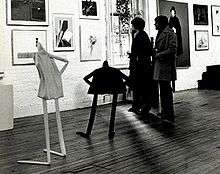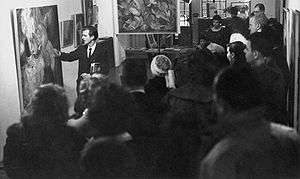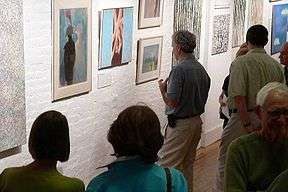Terrain Gallery
|
The Terrain Gallery | |
| Motto | "In reality opposites are one; art shows this" – Eli Siegel |
|---|---|
| Location |
|
| Coordinates | 40°43′34″N 73°59′56″W / 40.725989°N 73.99882°WCoordinates: 40°43′34″N 73°59′56″W / 40.725989°N 73.99882°W |
Co-Directors | Dorothy Koppelman and Carrie Wilson |
| Website | TerrainGallery.org |
The Terrain Gallery, or the Terrain, is an art gallery and educational center at 141 Greene Street in SoHo, Manhattan, New York City. It was founded in 1955 with a philosophic basis: the ideas of Aesthetic Realism and the Siegel Theory of Opposites, developed by American poet and educator Eli Siegel.[1] Its motto is a statement by Siegel: "In reality opposites are one; art shows this."
History
Under the direction of painter Dorothy Koppelman, the Terrain Gallery opened on February 26, 1955 with the publication of Siegel’s fifteen questions, Is Beauty the Making One of Opposites? (subsequently reprinted in The Journal of Aesthetics and Art Criticism).[2] Reviewing the opening exhibition, "Intersection '55", Parker Tyler wrote in Art News of the “explicitly inquiring and venturesome spirit” at the Terrain.[3] Bennett Schiff in the New York Post wrote that "there probably hasn't been a gallery before this like the Terrain, which devotes itself to the integration of art with all of living according to an esthetic principle which is part of an entire, encompassing philosophic theory...Aesthetic Realism developed and taught by Eli Siegel".[4]
From the beginning, the Terrain was simultaneously an exhibition space for contemporary art and a cultural center with "a lively and unconventional approach to aesthetic issues"[5] where artists, scholars, and the general public could learn about and discuss principles of Aesthetic Realism,[6] such as "The resolution of conflict in self is like the making one of opposites in art."[7]

Although exhibiting artists were not required to endorse Aesthetic Realism,[4] many wrote comments on the Siegel Theory of Opposites in relation to their work, which were displayed with their art.[8] Over the years, dozens of exhibition announcements, catalogues, and broadsides were printed and circulated by the Terrain, describing how the opposites in reality are central in art.[9]
Artists whose work has been exhibited at the Terrain Gallery include Ad Reinhardt, Larry Rivers, Chaim Koppelman, Robert Blackburn, Roy Lichtenstein, Hans Namuth, Dorothy Koppelman, André Kertész, Mark Di Suvero, Will Barnet, Richard Anuszkiewicz, Richard Artschwager, George Tooker, Lois Dodd, Jim Dine, Elaine de Kooning, and Steve Poleskie. Pop artist Richard Bernstein, optical artist Arnold Alfred Schmidt, photographers Nancy Starrels, Lou Dienes, Nat Herz, and others had their first one-person shows at the Terrain.[8]
Vietnam War protests
In the book The Indignant Eye, Ralph Shikes writes of how the Vietnam War brought many American artists into "active agitation".[10] The Koppelmans were among hundreds of artists who signed their names to an ad in the New York Times protesting the war in Vietnam in 1962.[11] In 1967, 105 painters, sculptors, printmakers and photographers participated in the exhibition All Art Is For Life and Against the War in Vietnam held at the Terrain to benefit napalm-burned and crippled Vietnamese children. Of Chaim Koppelman's print, "Vietnam", Shikes writes that the artist's "protest springs from the art and is not superimposed on it.”[10]
Location changes
First located at 20 West 16th Street, the Terrain Gallery moved in 1964 to 39 Grove Street in Greenwich Village, where it continued to hold art exhibitions and dramatic presentations of Aesthetic Realism.[12]
In 1973, the Terrain moved to the first floor of the not-for-profit Aesthetic Realism Foundation located at 141 Greene Street in Soho. There, the gallery featured a one-man show of drawings and silkscreens by Charles Magistro, and continued exhibitions such as "Big and Small" ("Art shows that nothing, however small, is without largeness and meaning"), and “The Arts, They’re Here!: Ten Arts and the Opposites," which included music and architecture.[13]
"Art Answers the Questions of Your Life"

In 1984, the Terrain Gallery began a new series of weekly talks, free to the public, called Art Answers the Questions of Your Life. These talks discussed topics such as precision and abandon in Jackson Pollock's action painting,[14] what mothers can learn about children from the art of Mary Cassatt, “Can Exuberance Be Sensible?: Hans Hofmann’s Rhapsody” by Bennett Cooperman, and "Logic and Emotion in Love and in the Shah Nameh by Barbara Buehler.[13] In her book, The Gothic Vision, (Continuum, London & New York, 2002), Dani Cavallaro quotes Dorothy Koppelman's talk on Picasso's Guernica: "Even as it takes on the cruelty and seeming non-sense in the world, there is form, there is organization, there is something larger than man’s inhumanity to man.” Cavallaro also writes:
| “ | In viewing Guernica as a major instance of the collusion of continuity and discontinuity, Koppelman also maintains that the painting is able "to make the ugliness of things bearable" and "to show those things as continuous with what we see as beautiful", and thus demonstrates the interdependence of appalling brokenness and life-affirming progression.[15] | ” |
An overview of this series of more than 175 talks on art of diverse genres and periods was presented by co-directors Dorothy Koppelman and Carrie Wilson at the 31st World Congress of the International Society for Education through Art (Teachers College, Columbia University, 2003).[16]
In 2005, the Terrain Gallery held a 50th anniversary exhibition that brought together works by 52 artists, several of whom contributed statements about how the Aesthetic Realism of Eli Siegel influenced their work.[17] A memorial exhibition for Chaim Koppelman, in 2010, included over six decades of the artist's prints, paintings, pastels, and sculpture, with critical comment.
Aesthetic Realism and the Siegel Theory of Opposites
The Terrain Gallery differed from other art galleries of the time in several ways. It held large group exhibitions that successfully combined diverse stylistic tendencies, such as realism and abstraction, when this was unusual.[18] Painting, sculpture, watercolor, and graphics were brought together under the titles "Abstract and Concrete,"[19] "Depth and Surface,"[20] "Logic and Emotion,"[21] and "Rest and Motion".[22] The Terrain Gallery also held “one of the first exhibitions honoring photography as a fine art”[23] and silkscreens as major work.[13]
The Seurat Art Club and the George Saintsbury Poetry Club

In 1955, the year it opened, the Terrain began a series of talks by the Seurat Art Club, working artists who spoke about the relevance of the Siegel Theory of Opposites to contemporary art and life.
Discussing both classical and contemporary work, club members considered the relation of composition in art and in life. They described art as having ethical implications, being "not an escape from life but a true picture of reality".[9]
Existing records of one of the discussions held at the Terrain in 1961 indicate that many artists felt that while opposites were undeniably present in their work, the conscious awareness of them would "lessen, or somehow destroy, the 'magic,' the 'talent,' the 'je ne sais quoi'" of art.[8] Others believed that "study of the opposites makes for an entirely new level of perception, a surer technique, a wider field of vision."[8] Painter Rolph Scarlett wrote: "The Siegel Theory of Opposites, which is the motivating consideration of this gallery, is inspiring."[8] Sculptor Barbara Lekberg, in an interview that appeared in the magazine American Artist, stated that Aesthetic Realism shows "not only that conscious knowledge can cause the unconscious to give up its riches, but also that this process of giving form to feeling has in it the principles of happiness for all people, not just artists." [24]
In addition to talks on art, the Terrain held poetry readings and discussions by the George Saintsbury Poetry Club.[25] The Terrain Gallery published Personal & Impersonal: Six Aesthetic Realists, a book of poems by Sheldon Kranz, Louis Dienes, Nancy Starrels, Nat Hertz, Martha Baird and Rebecca Fein[26] and held an exhibition of work by 45 artists, including Leonard Baskin, Robert Andrew Parker, and Nathan Cabot Hale, inspired by the poems.[27]
Response
Art critics generally praised exhibitions at the Terrain, but many ignored the philosophy behind these exhibitions, or wrote of it disparagingly.[1] When Art News published an interview with Tiffany award-winner Chaim Koppelman, founder of the printmaking division of the School of Visual Arts, an artist who considered Aesthetic Realism central to his work, the magazine omitted all mention of the philosophy, and even the word "opposites" did not appear.[28]
In response to the art critics, Mr. and Mrs. Koppelman placed an ad in The Village Voice in which they asked critics and artists to be fair to Aesthetic Realism and Eli Siegel:
We ask you, personally, to be fair to Aesthetic Realism and Eli Siegel...Aesthetic Realism is not a cult. We find bizarre the tendency in artists and critics to call Aesthetic Realism a cult while using it—under cover of "common knowledge"—to crystallize their own thoughts and writing on art...We cannot consider any person a friend who does not want to be fair to Aesthetic Realism and Eli Siegel...[29]
Dorothy and Chaim Koppelman both had one-person shows at the Terrain, and both were chosen for MoMA's 1962 exhibition "Recent Painting USA: The Figure."[13]
References
- 1 2 Dunsterville, Hilary, Art News, December 31, 1959.
- ↑ Siegel, Eli. “Is Beauty the Making One of Opposites?” The Journal of Aesthetics & Art Criticism, Vol. XIV, No. 2, December 1955.
- ↑ "Intersection '55", Art News, May 1955.
- 1 2 Schiff, Bennett (Sunday, June 16, 1957) "In the Art Galleries..." New York Post.
- ↑ http://www.jstor.org/pss/427148
- ↑ S.F. in Arts Digest, April 15, 1955.
- ↑ Reiss, Ellen (February 21, 2007). "Art & Your Life: The Same Subject". The Right of Aesthetic Realism to Be Known. Aesthetic Realism Foundation. Retrieved May 31, 2010.
- 1 2 3 4 5 "Terrain Gallery records, 1955–2005". Smithsonian Archives of American Art. Retrieved May 30, 2010.
- 1 2 Van Griethuysen, Ted (1969). Ted Van Griethuysen, ed. Aesthetic realism: we have been there: six artists on the Siegel theory of opposites. Definition Press. S. Kranz, p. 3.
- 1 2 Shikes, Ralph E. (1969). The Indignant Eye: The Artist as Social Critic in Prints and Drawings from the Fifteenth Century to Picasso. Beacon Press. pp. 369–370. ISBN 978-0-8070-6670-6.
- ↑ New York Times, Tuesday, June 26, 1962.
- ↑ Stern, Faith (February 13, 2002). "Scene of her mind change". The Villager. Retrieved May 30, 2010.
- 1 2 3 4 Wilson, Carrie (May 7, 2005). "A Brief History of the Terrain Gallery". Aesthetic Realism Foundation.
- ↑ Mariano, Lore. "Jackson Pollock's Number One 1948 or – How Can We Be Abandoned and Accurate at the Same Time?". TERRAIN GALLERY AESTHETIC REALISM FOUNDATION ONLINE LIBRARY. Retrieved May 30, 2010.
- ↑ Cavallero, Dani, The Gothic Vision, p. 121-2.
- ↑ "International Conversations through Art", Teachers College, Columbia University, 2003.
- ↑ Eaton, J. Sanders, Gallery & Studio, September/October 2005.
- ↑ Stone, Robert, "Abstract and Concrete", The Village Voice, March 28, 1956.
- ↑ Seckler, Dorothy Gees, Art in America, Spring 1956.
- ↑ Rackliffe, Howard, The Village Voice, May 9, 1956.
- ↑ "Logic and Emotion Mark Group Show". NY Times. December 17, 1955. Retrieved May 30, 2010.
- ↑ Goodman, Elizabeth, The Village Voice, May 29, 1957.
- ↑ Russo, Michael (May 11, 1980). "CAMERA; Some Galleries That Do Welcome New Talent". New York Times. Retrieved May 31, 2010.
- ↑ Dorothy Grafly, "Three Women Sculptors", Vol. 16, No. 2, February 1952, p. 58.
- ↑ ”Society Holds Poetry Inquiry,” The Village Voice, December 1, 1955.
- ↑ “Personal and Impersonal, Six Esthetic (sic) Realists: Poems by Sheldon Kranz, Louis Dienes, Nancy Starrels, Nat Hertz, Martha Baird, Rebecca Fein, with critical preface by Eli Siegel (Terrain Gallery)", "Books Today", New York Times, 1 June 1959,
- ↑ ”45 Artists and a Book of Poems,” The Villager May 14, 1959.
- ↑ William Kolodney, "Chaim Koppelman", ArtNews, September 1960.
- ↑ Koppelman, Chaim and Dorothy, “A Statement to the Art World”, The Village Voice, 1 March 1962.
